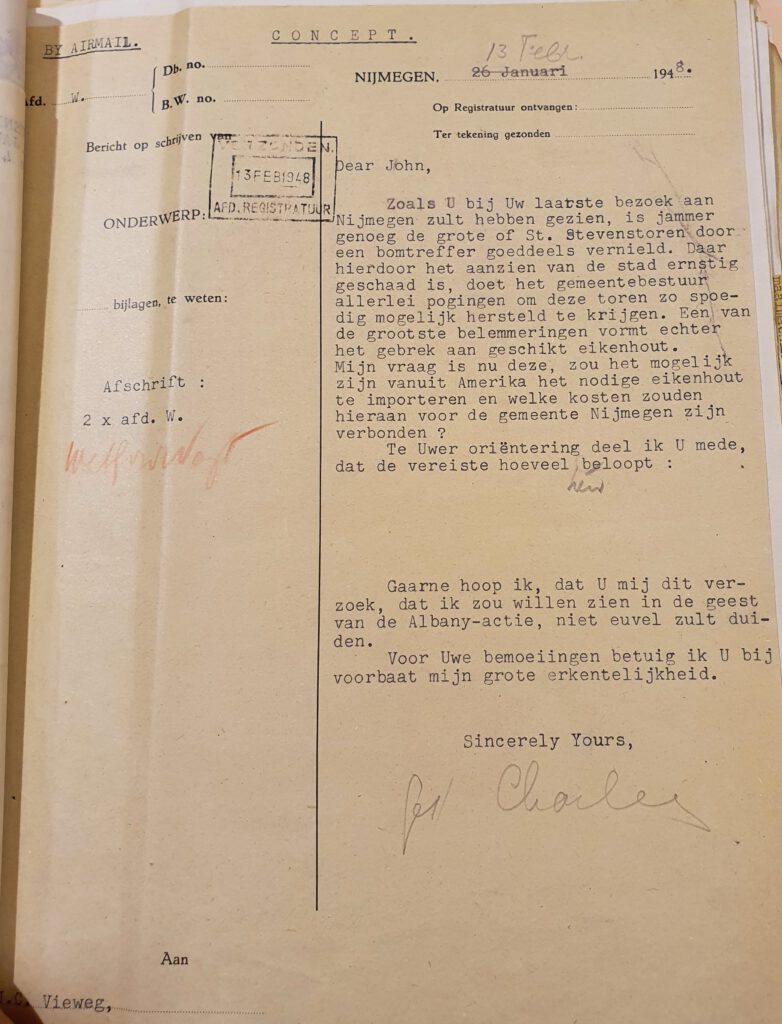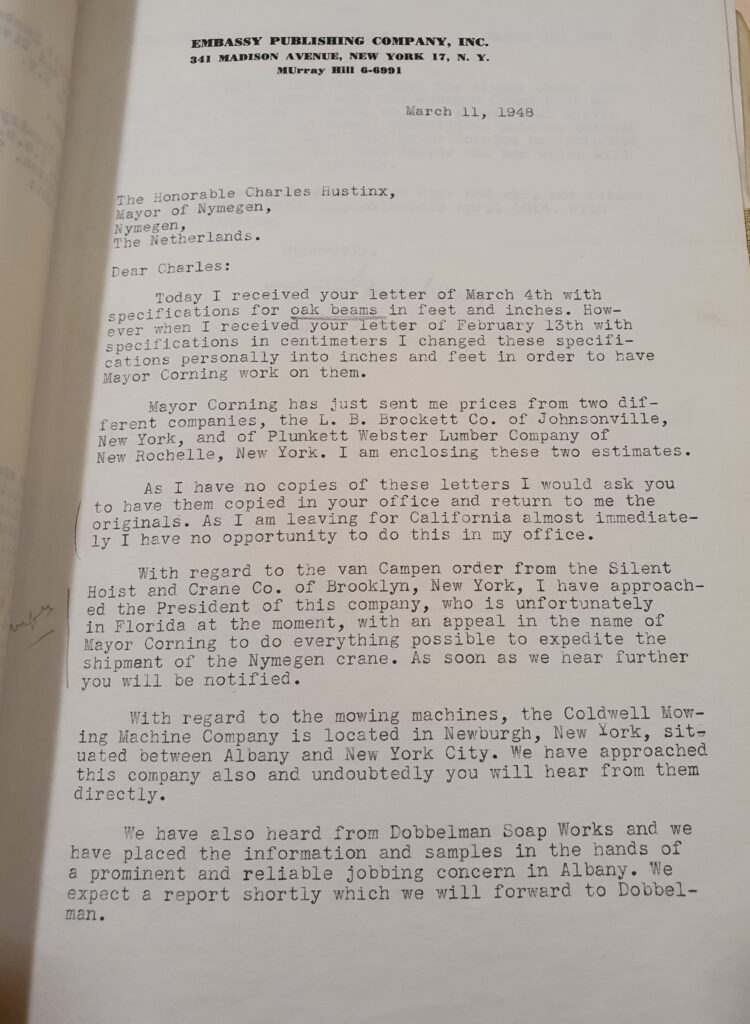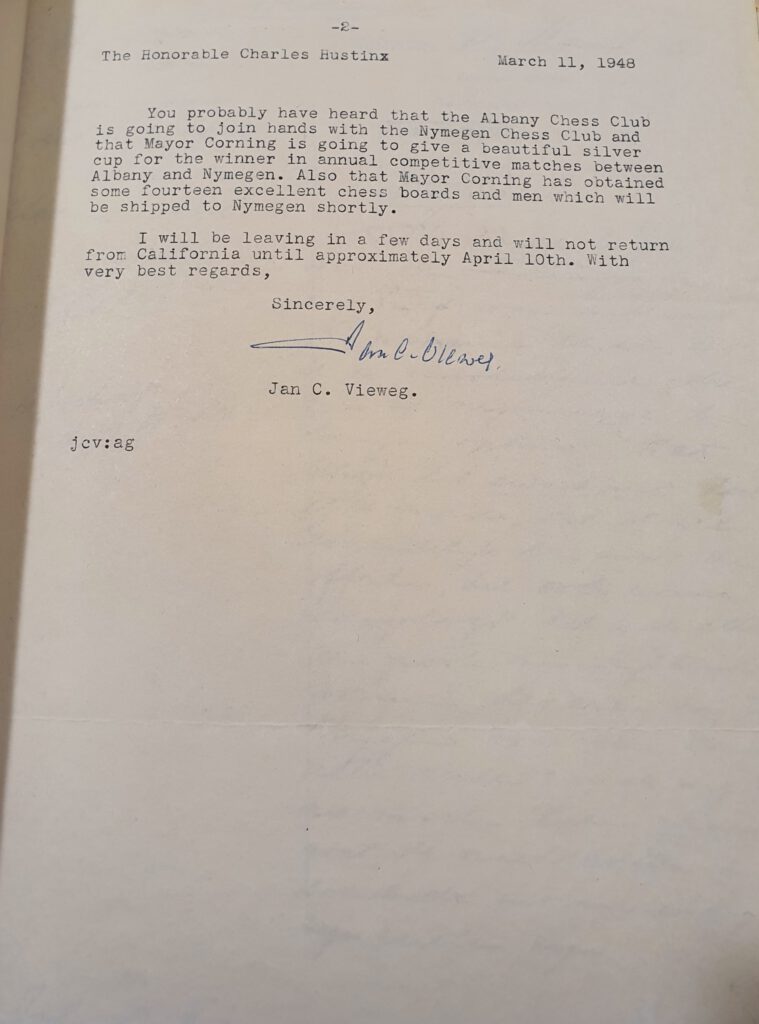Liberation
A Transatlantic friendship:
The request for american oak for the reconstruction of the stevenskerk
In 1947, the city of Albany adopted the city of Nijmegen with the help of the 82nd Airborne Division. This division, which was led by General Gavin, had liberated the city and wanted to do something back for the generous people of Nijmegen, who took care of soldiers while they hardly had anything themselves. The adoption consisted mostly of help for the reconstruction of the city since it had experienced many destructions due to the bombardment of 1944 and the liberation of the city. Additionally, connections between organizations and the municipalities were established. The Albany Nijmegen Committee was created to optimize the contact and aid offered by the citizens of Albany in these post-war years
The Stevenskerk

Image
Letter from Charles Hustinx about Request for Oak to John Vieweg. February 13, 1948. Images © RAN. 1222 Secretarie Gemeente Nijmegen / Maatschappelijke zorg 1946 – 1984. Inventarisnummer 10159. C. Hustinx . Letter about Request for Oak to John Vieweg. February 13, 1948.
Textual sources
Stichting Friendship Albany Nijmegen (FAN). Historie. Retrieved from: https://www.stichtingfan.nl/historie/
Regionaal Archief Nijmegen (RAN). 1222 Secretarie Gemeente Nijmegen / Maatschappelijke zorg 1946 – 1984. Inventarisnummer 10159.
‘De Kerkgeschiedenis in een Vogelvlucht’. Stevenskerk. Retrieved from: https://www.stevenskerk.nl/de-kerk/historie/
The city of Albany aided Nijmegen by, among other things, sending medicines, clothes, and kitchenware. However, within the Netherlands, there were not only shortages of clothes and kitchenware, but also shortages of paper and construction materials and tools, such as oak and cranes. Oak was crucial for reconstructions in the city, but especially for the reconstruction of the Stevenskerk. Nowadays, this church is probably the most iconic building within the skyline of Nijmegen. The church was built during the 13th century and a large part of the building did not survive the bombardment of 1944. During this bombardment, the tower of the church was almost completely damaged, just as its south-west chapel.
The church would not be restored entirely to its former state until 1969, but the plans and execution of its reconstruction started shortly after the war. In 1948, the Nijmegenaren asked their friends across the Atlantic for the supply of oak. The mayor of Nijmegen, Charles Hustinx, had been asked by architect A. Jansz to make a request for oak in the United States, since the city had been in close contact with Albany for a while already. Thereupon, Hustinx sent a letter to John Vieweg, who was the city’s contact person at the Embassy Publishing Company, in which he explained that the Stevenskerk had been damaged by a bombardment and that for the reconstruction they needed oakwood, which was not available in the area (image).
Oakwood
The mayor included a list with Dutch measurements. Probably after he realized that it would be more practical to include a list of American measurements, he sent that one as well. There was of course a difference in language in this friendship, but these more practical differences are important to note as well. Vieweg responded to Hustinx that the L.B. Brockett Lumber Company of Johnsonville, New York and Plunkett Webster Lumber Company of New Rochelle, New York had sent their pricelists for oakwood (images).
In another letter, the L.B. Brockett Lumber Company explained that they appreciated that this request was made, since this church was damaged by the war and they were more than willing to help.The close ties between the city of Nijmegen and Albany enabled city officials to reach out easier to their contacts about the supply of oakwood. There are, however, up until today still questions about the part of the church where this oakwood is incorporated. The oak incorporated in the Stevenskerk, despite its unknow amount, does up until today represent a transatlantic relation in this post-war era.
This relationship between Albany and Nijmegen and the request for oak is especially interesting to look into since the Stevenskerk has mostly been destructed by the bombardment of 1944 in which the Americans played a controversial role. This bombardment left many questions: was it intentional or a mistake? What can be said is that it destroyed a large piece of the city of Nijmegen and thus also the Stevenskerk. Then, was a sense of guilt the reason for why the Americans, in this case the people of Albany and New York State, helped the people of Nijmegen in any way possible? It probably has played a role. For example, the 82nd Division had seen the damages of the city and requested help for this city afterwards. They were probably also aware, at that time, that the city was damaged by American bombers. Another example is that the American lumber companies were more than willing to help with the oak since it was, first of all, because the damages had been a consequence of WWII, and also because it was a church.
Image
Letter from Charles Hustinx about Request for Oak to John Vieweg. February 13, 1948. Images © RAN. 1222 Secretarie Gemeente Nijmegen / Maatschappelijke zorg 1946 – 1984. Inventarisnummer 10159. J. Vieweg. Letter to Charles Hustinx about, among other things, the Price Lists of Lumber Companies. March 11, 1948.


Friendship
Finally, it can be noted that this adoption and later friendship are a constructed relation. The creation of the Albany Nijmegen Committee, the adoption, and the aid initiatives were considered carefully, and although it may seem like a very natural friendship, it has been consciously created. That does not mean, however, that this carefully created friendship is something suspect. The aid initiatives by and the connections with the people of Albany really helped out the city of Nijmegen. The adoption of the city of Nijmegen eventually changed into a friendship bond between its citizens, which even almost 75 years after its start is still intact.
It’s story and the friendship are, nowadays, represented by the Stichting Friendship Albany & Nijmegen.